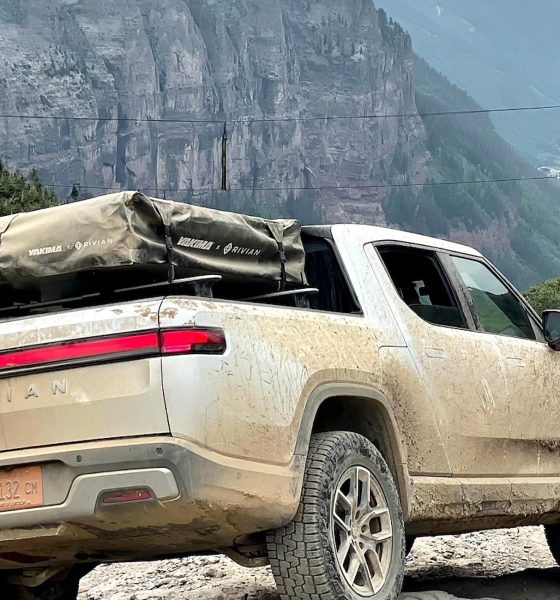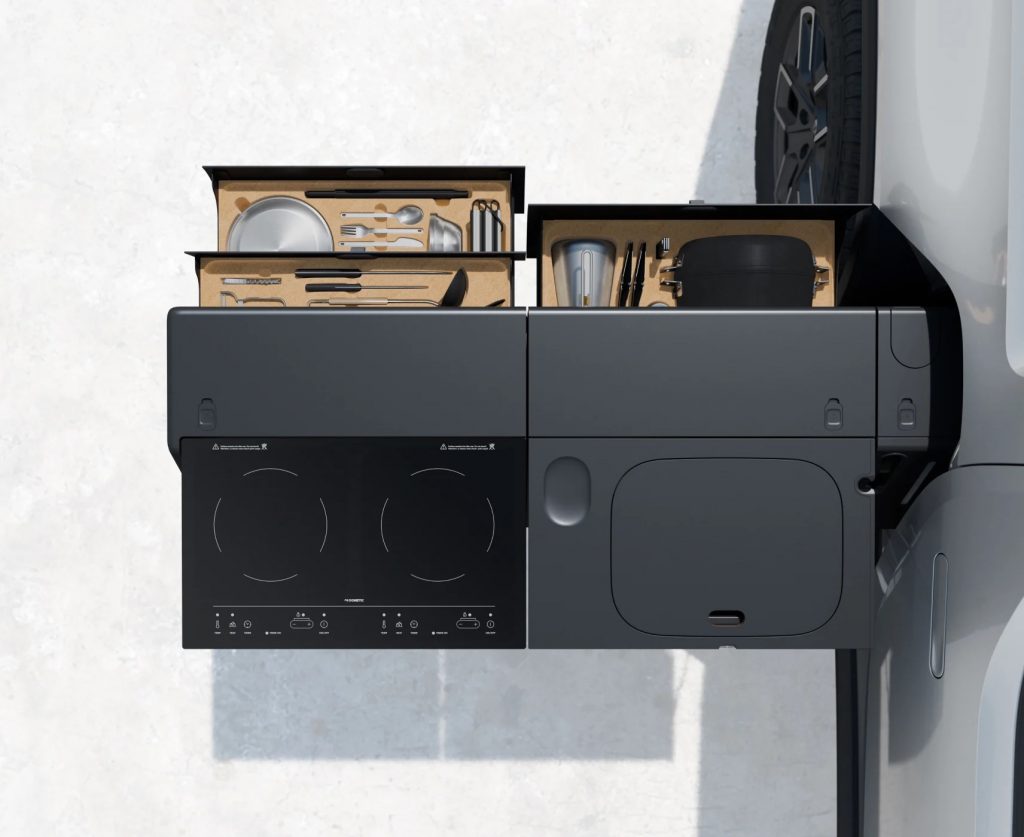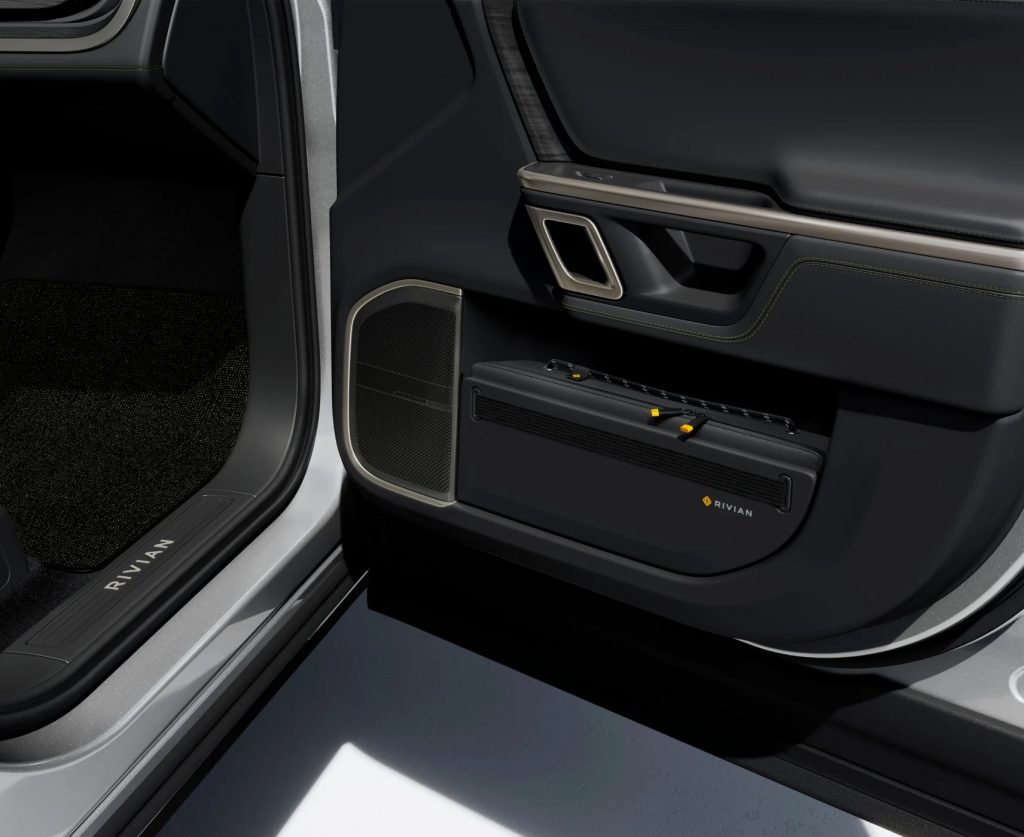

News
Rivian Gear shop reminds owners of the company’s sustainable adventure goals
Rivian’s Gear Shop is live just as the company prepares to price its initial public offering on Tuesday. The items in Rivian’s Gear Shop remind customers of its main purpose: to allow people to have outdoor adventures while also preserving nature for future generations.
The Gear Shop reflects Rivian’s approach in the electric vehicle market. The shop features T-shirts, sweatshirts, and caps with Normal, Illinois printed on them, almost like one of the souvenirs tourists buy during trips to new and fun places. There are also some T-shirts and caps that simply feature Rivian’s logo.

While all the Rivian shirts and caps are great for owners and supporters of the company, the most interesting part of the Gear Shop would be the actual gear available for purchase. The Rivian Camp Kitchen x Snow Peak Package is perhaps the perfect example of the company’s vision for the Gear Shop. The package includes three accessories: The Camp Kitchen, the Rivian Gear Tunnel Shuttle, and the Snow Peak Kitchen Set.
The Camp Kitchen is a modular kitchen that gives Rivian R1T owners a functional kitchen during outdoor adventures. The kitchen takes up 1,440 watts of power to run. It has a two-burner induction cooktop that Rivian claims can heat up a pot of chili quickly and still stay cool to the touch. The modular kitchen also comes with a 4-gallon water tank.
The Camp Kitchen is mounted onto and powered through the Gear Tunnel Shuttle, which is found in the R1T’s gear tunnel. The Gear Tunnel Shuttle is required to operate the Camp Kitchen. To install the shuttle, Rivian owners must go to a service center.

The last piece of the package is the Snow Peak kitchen set. It is a 30-piece set that fully compliments the Camp Kitchen. The Snow Peak kitchen set includes cooking accessories like a nylon & bamboo spatula, a nylon ladle, a kettle, and knives. The set also includes a 4-piece cutlery set, bolts, plates, and six mugs. And Rivian didn’t forget to add some lighting into the set either, as it comes with a string of lights and a pole.
Rivian hasn’t listed the price of the Rivian Camp Kitchen x Snow Peak Package. However, the Gear Shop states the package is coming soon, and shipping is free in the United States.
Along with a kitchen, Rivian also thought of accommodations while owners are enjoying nature. The Gear Shop listed a three-person tent package, which includes a ladder, cargo crossbars, and a 2.5” thick wall-to-wall foam mattress. The crossbars are required to mount the tents onto the R1S or R1T.

Another notable item in the Gear Shop would be Rivian’s Field Kit. The Field Kit costs $150 and fits snugly along the passenger door of the R1T pickup. It contains emergency care items like bandages , burn shield dressing, disposable gloves, gauze pads, and a finger splint.
Rivian’s Gear Shop is full of other accessories that could enhance someone’s outdoor adventures. Rivian will probably release more accessories and maybe even appropriate apparel for outdoor adventures in the future. The company’s founder and CEO RJ Scaringe has stated in the past that he would like Rivian vehicles to have a “Patagonia-like feel of enabling adventure.” It stands to reason that the same goes for the items Rivian releases in its Gear Shop.
The Teslarati team would appreciate hearing from you. If you have any tips, reach out to me at maria@teslarati.com or via Twitter @Writer_01001101.

News
Tesla starts showing how FSD will change lives in Europe
Local officials tested the system on narrow country roads and were impressed by FSD’s smooth, human-like driving, with some calling the service a game-changer for everyday life in areas that are far from urban centers.

Tesla has launched Europe’s first public shuttle service using Full Self-Driving (Supervised) in the rural Eifelkreis Bitburg-Prüm region of Germany, demonstrating how the technology can restore independence and mobility for people who struggle with limited transport options.
Local officials tested the system on narrow country roads and were impressed by FSD’s smooth, human-like driving, with some calling the service a game-changer for everyday life in areas that are far from urban centers.
Officials see real impact on rural residents
Arzfeld Mayor Johannes Kuhl and District Administrator Andreas Kruppert personally tested the Tesla shuttle service. This allowed them to see just how well FSD navigated winding lanes and rural roads confidently. Kruppert said, “Autonomous driving sounds like science fiction to many, but we simply see here that it works totally well in rural regions too.” Kuhl, for his part, also noted that FSD “feels like a very experienced driver.”
The pilot complements the area’s “Citizen Bus” program, which provides on-demand rides for elderly residents who can no longer drive themselves. Tesla Europe shared a video of a demonstration of the service, highlighting how FSD gives people their freedom back, even in places where public transport is not as prevalent.
What the Ministry for Economic Affairs and Transport says
Rhineland-Palatinate’s Minister Daniela Schmitt supported the project, praising the collaboration that made this “first of its kind in Europe” possible. As per the ministry, the rural rollout for the service shows FSD’s potential beyond major cities, and it delivers tangible benefits like grocery runs, doctor visits, and social connections for isolated residents.
“Reliable and flexible mobility is especially vital in rural areas. With the launch of a shuttle service using self-driving vehicles (FSD supervised) by Tesla in the Eifelkreis Bitburg-Prüm, an innovative pilot project is now getting underway that complements local community bus services. It is the first project of its kind in Europe.
“The result is a real gain for rural mobility: greater accessibility, more flexibility and tangible benefits for everyday life. A strong signal for innovation, cooperation and future-oriented mobility beyond urban centers,” the ministry wrote in a LinkedIn post.
News
Tesla China quietly posts Robotaxi-related job listing
Tesla China is currently seeking a Low Voltage Electrical Engineer to work on circuit board design for the company’s autonomous vehicles.

Tesla has posted a new job listing in Shanghai explicitly tied to its Robotaxi program, fueling speculation that the company is preparing to launch its dedicated autonomous ride-hailing service in China.
As noted in the listing, Tesla China is currently seeking a Low Voltage Electrical Engineer to work on circuit board design for the company’s autonomous vehicles.
Robotaxi-specific role
The listing, which was shared on social media platform X by industry watcher @tslaming, suggested that Tesla China is looking to fill the role urgently. The job listing itself specifically mentions that the person hired for the role will be working on the Low Voltage Hardware team, which would design the circuit boards that would serve as the nervous system of the Robotaxi.
Key tasks for the role, as indicated in the job listing, include collaboration with PCB layout, firmware, mechanical, program management, and validation teams, among other responsibilities. The role is based in Shanghai.
China Robotaxi launch
China represents a massive potential market for robotaxis, with its dense urban centers and supportive policies in select cities. Tesla has limited permission to roll out FSD in the country, though despite this, its vehicles have been hailed as among the best in the market when it comes to autonomous features. So far, at least, it appears that China supports Tesla’s FSD and Robotaxi rollout.
This was hinted at in November, when Tesla brought the Cybercab to the 8th China International Import Expo (CIIE) in Shanghai, marking the first time that the autonomous two-seater was brought to the Asia-Pacific region. The vehicle, despite not having a release date in China, received a significant amount of interest among the event’s attendees.
Elon Musk
Elon Musk and Tesla AI Director share insights after empty driver seat Robotaxi rides
The executives’ unoccupied tests hint at the rapid progress of Tesla’s unsupervised Robotaxi efforts.

Tesla CEO Elon Musk and AI Director Ashok Elluswamy celebrated Christmas Eve by sharing personal experiences with Robotaxi vehicles that had no safety monitor or occupant in the driver’s seat. Musk described the system’s “perfect driving” around Austin, while Elluswamy posted video from the back seat, calling it “an amazing experience.”
The executives’ unoccupied tests hint at the rapid progress of Tesla’s unsupervised Robotaxi efforts.
Elon and Ashok’s firsthand Robotaxi insights
Prior to Musk and the Tesla AI Director’s posts, sightings of unmanned Teslas navigating public roads were widely shared on social media. One such vehicle was spotted in Austin, Texas, which Elon Musk acknowleged by stating that “Testing is underway with no occupants in the car.”
Based on his Christmas Eve post, Musk seemed to have tested an unmanned Tesla himself. “A Tesla with no safety monitor in the car and me sitting in the passenger seat took me all around Austin on Sunday with perfect driving,” Musk wrote in his post.
Elluswamy responded with a 2-minute video showing himself in the rear of an unmanned Tesla. The video featured the vehicle’s empty front seats, as well as its smooth handling through real-world traffic. He captioned his video with the words, “It’s an amazing experience!”
Towards Unsupervised operations
During an xAI Hackathon earlier this month, Elon Musk mentioned that Tesla owed be removing Safety Monitors from its Robotaxis in Austin in just three weeks. “Unsupervised is pretty much solved at this point. So there will be Tesla Robotaxis operating in Austin with no one in them. Not even anyone in the passenger seat in about three weeks,” he said. Musk echoed similar estimates at the 2025 Annual Shareholder Meeting and the Q3 2025 earnings call.
Considering the insights that were posted Musk and Elluswamy, it does appear that Tesla is working hard towards operating its Robotaxis with no safety monitors. This is quite impressive considering that the service was launched just earlier this year.








